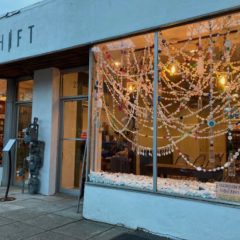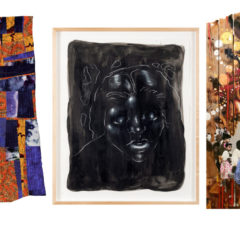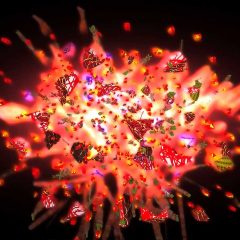A trip west of City Avenue is, for some Philadelphians, a detour into warp space. Although they live only minutes away, many residents of Fresh Prince and Jazzy Jeff’s home turf have never heard of Haverford and Bryn Mawr. Denizens of the Main Line, it would appear, are likewise ignorant of inner city culture. Urban Pop at the Main Line Art Center (March 20-April 12, 2013) proposes to bridge that gap by exhibiting work by artists who, if not of the urban core, have at least absorbed its visual vocabulary.
DISTORT is, as the all-caps moniker implies, a graffiti writer. Although tagging the Main Line Art Center was not an option, DISTORT did manage to haul in some large pieces of urban grit in the form of paintings on scrap metal. Ascent to Calvary blends the dystopian and the baroque, with a phalanx of figures wandering a doomed city à la Watchmen or Zombie Apocalypse. The artist weaves the same sensibility into the painted scrolls he has fashioned out of unraveled spray cans, which show twisters ripping through buildings. Although expert in the handling of metals, DISTORT’s paint application has a pasty quality reminiscent of Eric Fischl. Most successful—and most indebted to the baroque—is Tenebrism, in which the artist etches a strictly monochrome image of Caravaggio’s David with the Head of Goliath into the hood of a Chevelle. In black and white the work is more focused, and the playful pairing of Caravaggio and muscle car is a breath of fresh air.
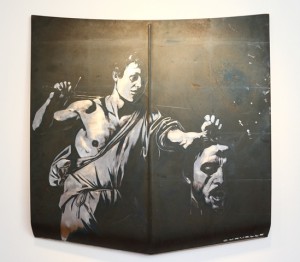
Whether for masking off a paint job, wrapping a wire, or joining drywall sheets, tape is any urban pioneer’s friend. Jay Walker uses tape of all types to make art — both room-sized installations and framed works. In Pyrotokos I, cross-hatched electrical tape lines form the image of cloaked figure with clasped hands and then meander over the ceiling to join a series of lightning bolts and fire-spitting bulbs. In Theotokos XXIX, a headless red-hooded figure commands a pile of stenciled skulls. Walker’s vivid colors and contrasting textures sometimes work against cohesion. The eye loses its way halfway across the ceiling in Pyrotokos, and in Theotokes, the various patterns used to make the form (crosses, parallel lines, cutouts) sometimes break into separate heaps.
Pyrotokos’ cloaked, haloed figure seems devotional, and Theotokos is Greek for “god bearer,” but Walker claims no particular religious affiliation. Like wheat paste posters or street stencils, the works grab the attention of passers-by, but leave them hanging. The repetition of the loaded image propagates the maker’s name as much the idea behind it.
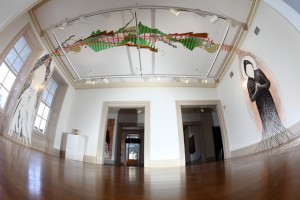
Leslie Friedman’s printed linoleum tiles are less agnostic. She also starts with a material available at Home Depot, but covers it with it with signs of her Jewish background. The tiles that pave her Sukkot Ramp, for example, are imprinted in hot pinks with stars of David, a middle-eastern tessellation and ritual objects from the Jewish holiday of Sukkot. Rows of similar tiles in Fun Guys bear darker imagery: a hairy-chested gentleman sporting a gold Star of David; a hundred dollar bill; a silhouette of Barbara Streisand with an enormous nose; and an anti-Semitic caricature of an avaricious looking man with horns. Friedman’s use of glitter and brash colors might be appropriate for a girl who just had her Bat Mitzvah, yet the inclusion of stereotypes defies cheerful innocence.
Friedman explained to me that her use of tile as pavement for ramps was a nod to urban skateboarding culture, but what’s really urban about her work is its unabashed Jewishness. Loud colors and patterns paired with unsubtle reminders of anti-Semitism reference a time when Jews did live on the other side of City Avenue—and some people would have preferred that they stay there.
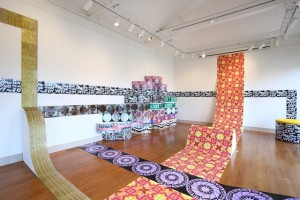
Though the exhibition sometimes forces the artists’ work into obvious urban tropes (e.g. skateboarding and junk art), and individual pieces vary in their execution, Urban Pop is an ambitious project. I credit curator Amie Potsic—also the Main Line Art Center’s new director—for challenging her audiences with new subject matter, unusual materials, and art that breaks out of the frame or leaps off the pedestal. The work in the exhibition dares audiences to re-examine the way their metropolis has been assembled.
Urban Pop is on view until April 12 at the Main Line Art Center, 746 Panmure Road in Haverford, PA. Next week I’ll look at a much different approach to urban art when I review Daniel Petriatis’s exhibition Can I Live To My Last Day at Rebekah Templeton.



